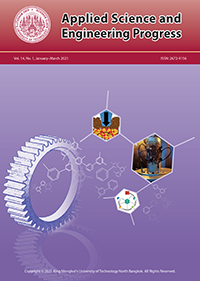Cost-effectiveness of Solar Cooling for Office and Hypermarket
Main Article Content
Abstract
Air-conditioning consumes electricity intensively in Thailand and it is desirable to investigate if less intensive means of cooling is viable. This paper presents results of assessment of financial viability of application of solar cooling employing single-effect absorption chiller to a large office building model and a hypermarket model under Thai context. The well-known TRNSYS program is used to simulate operation of solar cooling system in the two building models under a solar autonomous mode and an electric chiller-assisted solar cooling mode. Multiple simulation runs with variation on the size of hot water tank and solar collector area were conducted to obtain the solar autonomous configuration and the electric chiller-assisted configuration that offers lowest life cycle cost (LCC) for each building type. The LCCs for both types of buildings under electric chiller-assisted mode at optimum configuration are lower than that from electric cooling. Payback periods for optimum solar cooling mode are all positive for both building types, although relatively long, at 24 and 26 years. If solar equipment is subsidized under a 30/70% scheme, payback periods could be reduced to 14 and 16 years. The prospect for solar thermal cooling is positive.
Article Details
References
[2] S. Chirarattananon, Building for Energy Efficiency. Bangkok, Thailand: Asian Institute of Technology, 2005.
[3] Department of Alternative Energy Development and Efficiency. (2007). Solar Radiation Maps of Thailand. DEDE. Bangkok, Thailand. [Online]. Available: http://www2.dede.go.th/dede/renew/ sola/mapmenu.html
[4] Energy Planing and Policy. (2016). Alternative Energy Development Plan. EPPO. Bangkok, Thailand. [Online]. Available: http://www.eppo. go.th/index.php/en/ policy-and-plan/en-tieb/tiebaedp
[5] T. S. Ge, R. Z. Wang, Z. Y. Xu, Q. W. Pan, S. Du, X. M. Chen, and J. F. Chen, “Solar heating and cooling: Present and future development,” Renewable Energy, vol. 126, pp. 1126–1140, 2018.
[6] A. Pongtornkulpanich, S. Thepa, M. Amornkitbamrung, and C. Butcher, “Experience with fully operational solar-driven 10-ton LiBr/H2O single-effect absorption cooling system in Thailand,” Renewable Energy, vol. 33, no. 5, pp. 943–949, 2008.
[7] M. Balghouthi, M. H. Chahbani, and A. Guizani, “Feasibility of solar absorption air conditioning in Tunisia,” Building and Environment, vol. 43, no. 9, pp. 1459–1470, 2008.
[8] F. Calise, A. Palombo, and L. Vanoli, “Maximization of primary energy savings of solar heating and cooling systems by transient simulations and computer design of experiments,” Applied Energy, vol. 87, no. 2, pp. 524–540, 2010.
[9] F. Agyenim, I. Knight, and M. Rhodes, “Design and experimental testing of the performance of an outdoor LiBr/H2O solar thermal absorption cooling system with a cold store,” Solar Energy, vol. 84, no. 5, pp. 735–744, 2010.
[10] Y. Ma, S. Saha, W. Miller, and L. Guan, “Comparison of different solar-assisted air conditioning systems for Australian office buildings,” Energies, vol. 10, no. 10, pp. 1463-1–1463-7, 2017.
[11] E. Bellos and C. Tzivanidis, “Energetic and financial analysis of solar cooling systems with single effect absorption chiller in various climates,” Applied Thermal Engineering, vol. 126, pp. 809–821, 2017.
[12] Apogee Interactive. (1993). Compare - Installed Costs – Chillers. Apogee Interactive. Wilmington, US. [Online]. Available: http://c03.apogee.net/ contentplayer/?coursetype=ces&utilityid=north western&id=1084
[13] University of Wisconsin, “TRNSYS 18: A transient system simulation program,” University of Wisconsin, Madison, USA, 2014.
[14] J. A. Duffie and W. A. Beckman, Solar Engineering of Thermal Processes, 4nd ed. New Jersey: John Wiley & Sons, 2003, pp. 67.
[15] ECOTHERM. (2011). Product Specifications and Design Guide. ECOTHERM. Austria. [Online]. Available: http://www.ecotherm.com/upload/ files/ Produkte/ESC-V6-V12-V18.pdf
[16] J. E. Braun, “Methodologies for the design and control of chilled water systems,” Ph.D. dissertation, Department of Mechanical Engineering, Faculty of Engineering, University of Wisconsin, Madison, USA, 1988.
[17] Metropolitan Electricity Authority. (2018, Nov.). Large General Service. MEA. Bangkok, Thailand. [Online]. Available: https://www.mea.or.th/en/ profile/109/114
[18] P. Sirasoontorn, “Electricity tariff regulation in thailand: Analyses and applications of incentive regulation,” in Infrastructure Regulation: What Works, Why and How Do We Know?. Singapore: World Scientific, 2011, pp. 153–188.
[19] N. Saeneerattanaprayune, J. Taweekun, C. Kooptarnond, and P. Ngamsritragul, “A study on efficiency of solar collector for hot water generation using energyplus program,” in Proceedings of the Conference of Mechanical Engineering Network of Thailand, 1891, pp. 1282–1287.
[20] Energy Policy and Planning Office. (2016). Thailand Energy Efficiency Development Plan. EPPO. Bangkok, Thailand. [Online]. Available: http://www.eppo.go.th/index. php/en/policy-andplan/ en-tieb/tieb-eep
[21] Z. Y. Xu, R. Z. Wang, and H. B. Wang, “Experimental evaluation of a variable effect LiBr–water absorption chiller designed for high-efficient solar cooling system,” International Journal of Refrigeration, vol. 59, pp. 135–143, 2015.


